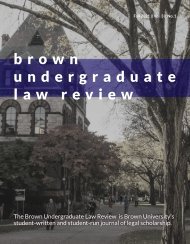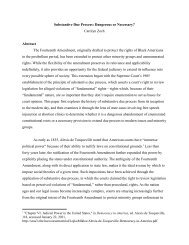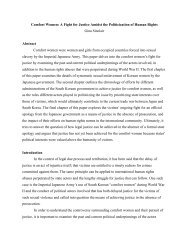Brown Undergraduate Law Review — Vol. 2 No. 2 (Spring 2021)
We are proud to present the Spring 2021 issue of the Brown Undergraduate Law Review. We hope that the works contained herein offer insight and inspiration to all who read them.
We are proud to present the Spring 2021 issue of the Brown Undergraduate Law Review. We hope that the works contained herein offer insight and inspiration to all who read them.
You also want an ePaper? Increase the reach of your titles
YUMPU automatically turns print PDFs into web optimized ePapers that Google loves.
Targeting Muslims and Civil Liberties Prevention:<br />
An Analysis of the Countering Violent Extremism Program?s First Amendment Violations<br />
repeated displays of anti-Muslim animus by the Trump<br />
administration and their implementation of the CVE<br />
program.<br />
more than a ?religious gerrymander.?? 53 Justice Sotomayor<br />
concludes that there does not need to be an explicit<br />
mention of religion for there to be Establishment Clause<br />
violations in the Muslim ban, as ?the record? establishes<br />
Justice Sotomayor?s dissenting opinion in Trump v. Hawaii<br />
that ?the President campaigned on a promise to implement<br />
(2018) provides an important precedent in establishing the<br />
?a total and complete shutdown on Muslims?entering the<br />
viability of considering the government?s intent when<br />
country, translated that campaign promise into a concrete<br />
attempting to review the constitutionality of a<br />
policy, and made several statements linking that policy (in<br />
governmental policy. Trump v. Hawaii deals with the<br />
constitutionality of the Executive Order 13780, more<br />
commonly known as the Muslim ban. In her dissenting<br />
opinion, Justice Sotomayor cites that the Court<br />
[h]as generally considered the text of the government<br />
policy, its operation, and any available evidence<br />
regarding ?the historical background of the decision<br />
under challenge, the specific series of events leading to<br />
the enactment or official policy in question, and the<br />
its various forms) to anti-Muslim animus.? 54<br />
Establishment Clause and CVE<br />
In applying Justice Sotomayor?s framework in Trump v.<br />
Hawaii to the constitutionality of CVE, one clearly sees<br />
that CVE can be considered unconstitutional due to its<br />
violation of the Establishment Clause. Like the Muslim<br />
ban, Trump?s repeated anti-Muslim statements and<br />
comments can be used to show a pattern of anti-Muslim<br />
legislative or administrative history, including animus that has guided the implementation of CVE, as<br />
contemporaneous statements made by? the indicated specifically by his comments advocating for<br />
decisionmaker. 50<br />
surveillance of mosques and a national registry of<br />
American Muslims. Unlike the Muslim ban at issue in<br />
Next, Justice Sotomayor quotes many of Trump?s<br />
Trump v. Hawaii, CVE is very explicit in its targeting of<br />
anti-Muslim statements and comments in order to<br />
Muslim communities.<br />
demonstrate a pattern of anti-Muslim animus that would<br />
then inform the signing of the Muslim ban. 51 Justice<br />
Sotomayor argues that under the endorsement test, a<br />
Almost all of the pilot CVE programs? strategic<br />
frameworks identified Muslim and/or predominantly<br />
rational observer ?would conclude that the primary Muslim ethnic communities as primary sites of<br />
purpose of the Proclamation is to disfavor Islam and its<br />
adherents by excluding them from the country,? thereby<br />
constituting a violation of the Establishment Clause. 52 In<br />
subjecting the issue to the strict scrutiny standard<br />
necessary in an Establishment Clause case, Justice<br />
Sotomayor finds the national security interests mentioned<br />
in the majority?s opinions to be insufficient and ?nothing<br />
engagement for counterterror activity. In addition, all CVE<br />
frameworks are heavily influenced by FBI and NYPD<br />
counterterror frameworks and strategies, which essentialize<br />
Muslims as inherently predisposed to extremism and<br />
correlate adherence to Islam with extremism. This pattern<br />
demonstrates a level of anti-Muslim animus and<br />
unconstitutional disfavoring of Muslims that predates the<br />
50. Ibid., 585 U.S. __, slip. op., 3-4 (Sotomayor, J., dissenting).<br />
51. Ibid., 585 U.S. __, slip. op., 4-10 (Sotomayor, J., dissenting).<br />
52. Ibid., 585 U.S. __, slip. op., 10 (Sotomayor, J., dissenting).<br />
53. Ibid., 585 U.S. __, slip. op., 17 (Sotomayor, J., dissenting).<br />
54. Ibid., 585 U.S. __, slip. op., 17-18 (Sotomayor, J., dissenting).<br />
<strong>Brown</strong> <strong>Undergraduate</strong> <strong>Law</strong> <strong>Review</strong><br />
30










